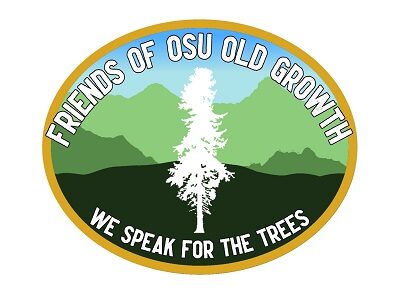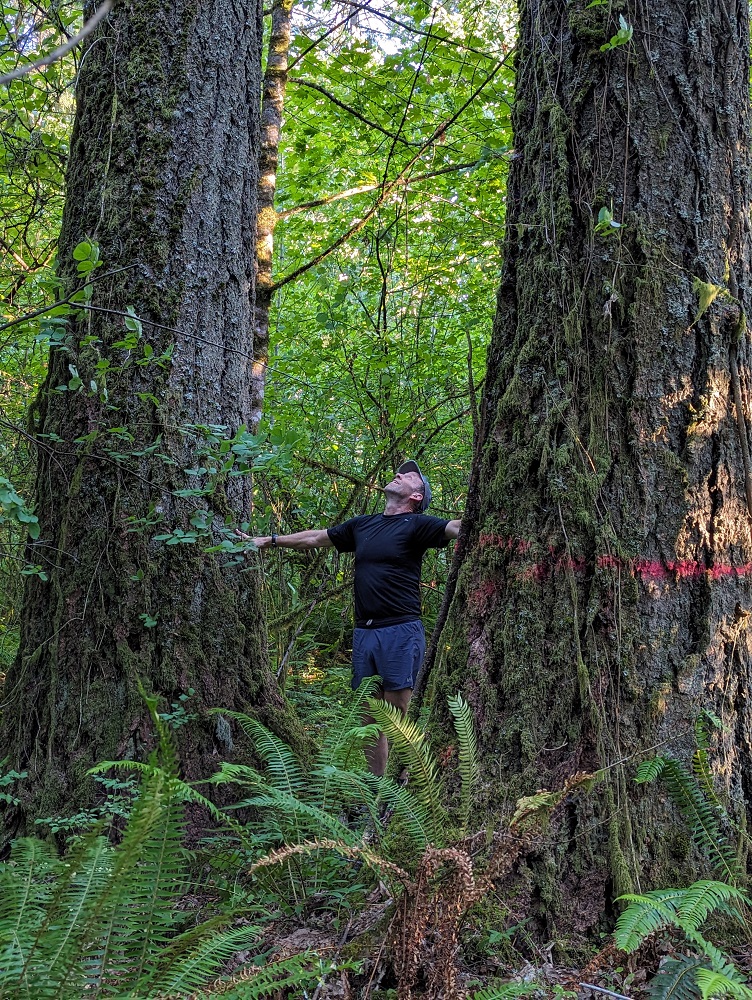
The large, old tree on the right has been marked for cutting by OSU’s foresters. Since trees are connected through mycorrhizal networks, cutting one large “mother tree” will adversely impact the surrounding forest community.
OSU’s latest logging project in the McDonald Forest is arguably the most blatant and outrageous example of what’s wrong with their outdated approach to forestry since their 2019 old-growth cut. Named, “Woodpecker_Phase1”, the cut is described as, “Demonstration of multi-aged managed forests while maintaining structural diversity and associated habitats within the stand“. From OSU’s perspective, a forest must be “managed” (logged or thinned) in order to be “productive” – even when the stand is 108 years old (like this one). From the public’s perspective, the destruction of these old trees within a prized recreation area exemplifies the greed and arrogance of College leaders.
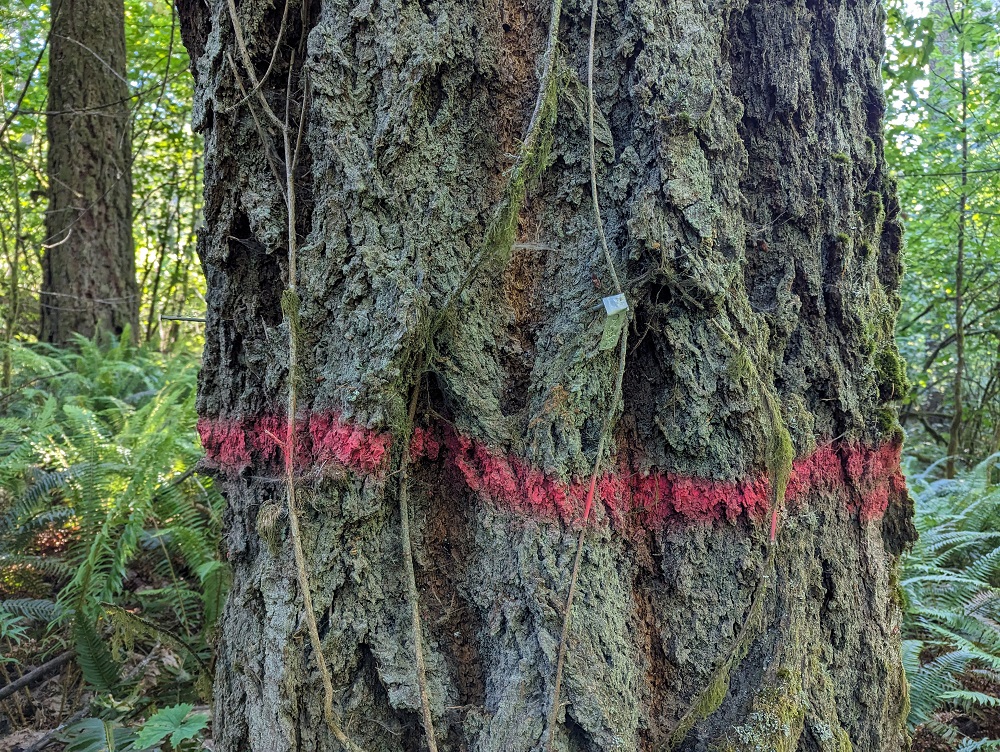
A large, old tree marked for cutting near Cronemiller Lake.
How exactly OSU foresters expect to “maintain structural diversity and associated habitats” by destroying scores of large, old trees across 64 acres defies comprehension. Clearly they believe cutting a substantial area of forest that is already structurally-diverse is a good and necessary thing. When logging is your business (and the pay-off is huge), then even older forests need to be “managed”. This is the same approach we see in OSU’s developing forest plan, where reserves that were formerly off limits to logging are now slated to become “managed reserves”.
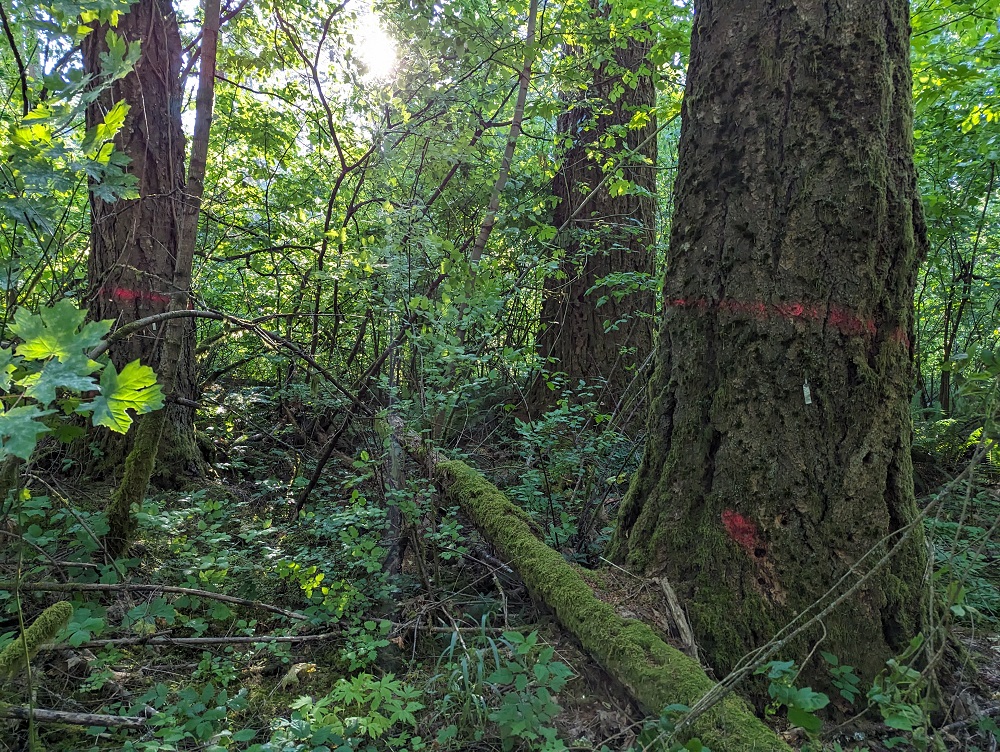
Two of three older trees will be cut from this section of ecologically diverse, older forest near the Peavy Arboretum.
From an ecological and human perspective, all of this is utter nonsense. Generations of Corvallis citizens have enjoyed the majestic old trees near Cronemiller Lake that will soon be cut. They understand that OSU’s claim of creating “structural diversity” is just an excuse to justify the lucrative logging. They also know that this magnificent forest would transition into an old-growth ecosystem over the next 50 years all on its own. It doesn’t need chainsaws and feller bunchers to help it along. As OSU’s own experts (Dr’s. Jerry Franklin and K. Norman Johnson) testified so powerfully in the Elliott State Research Forest process in 2019:
OSU’s ‘Forest Update’ (from June 17th, 2024) contains the following information for this logging operation:


OSU’s ‘Woodpecker Phase1’ cut will consist of a 10.5 acre clearcut and thinning of ~64 acres of older forest in the most popular area of the McDonald Forest (near Peavy Arboretum). This section of forest will be closed for 2-1/2 months during the peak recreation period.
While OSU claims it will be “thinning to a variable spacing” across more than 48 acres of the stand, my own field-checking and photographs revealed a very different story. In one section of older forest after another, OSU’s foresters have uniformly marked 1/3 to 1/2 of the trees for cutting (with a line of red paint around the trunks). As one ventures further from the main road, one discovers an increasing number of big trees marked for culling. It is as if they decided they could get away with cutting bigger trees by simply taking them from areas that are less visible. Maybe this is the “variable thinning” OSU is promoting in this cut…”cut more and cut bigger trees in the areas that are harder to see“.
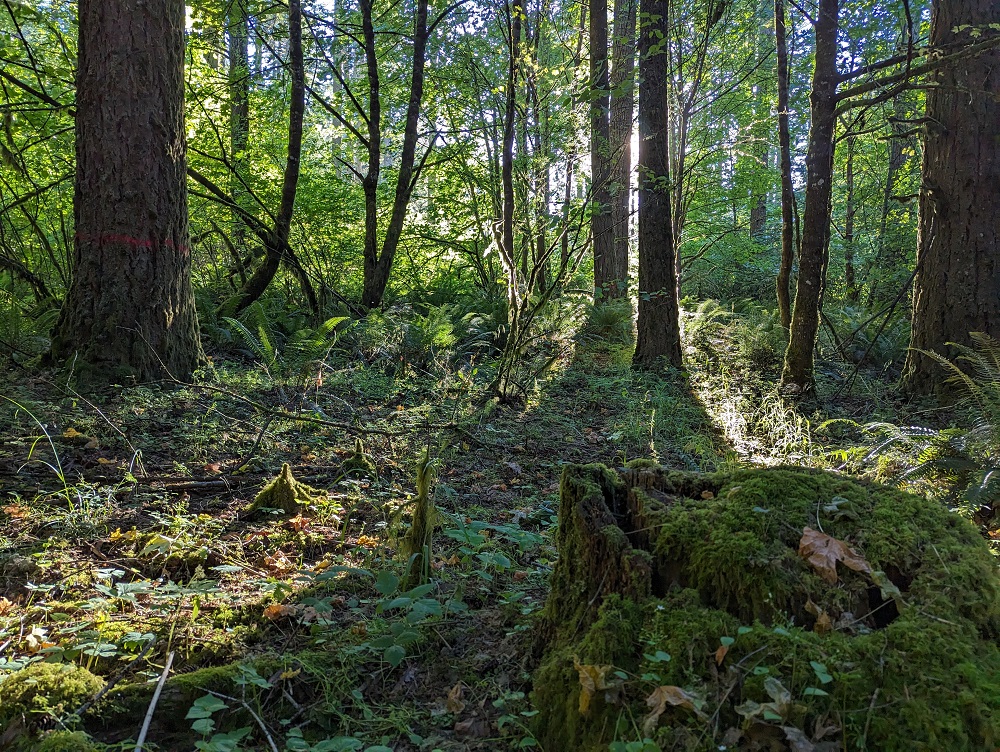
Three of four Douglas-fir trees in this section are marked for cutting. The large stump in the foreground is from OSU’s previous thinning of this forest a generation ago.
Note that OSU’s “harvest map” does not indicate where the 10.5-acre “patch cut” will occur. College leaders typically don’t provide this level of information (even when we’ve requested it). Their standard response is to tell us to file a public records request. One wonders how a 10.5-acre clearcut can be defined as a “patch cut”, when the existing 2005 management plan limits cuts in the “south zone” of McDonald Forest to 4 acres in size. I guess they thought “patch cut” would sound less destructive (“Hey, we’re only going to cut a little patch of forest!“).
The fact that OSU describes the destruction of older forest as “contributing to a sustainable harvest goal” shows a glaring lack of understanding of the entire concept of sustainability. There is nothing sustainable about cutting trees 2-3X older than the average industry rotation. Research by OSU’s own experts shows these older forests are critical to mitigating climate change. Older forests are also much more resistant to wildfire and serve as a refugium for both wildlife and people.
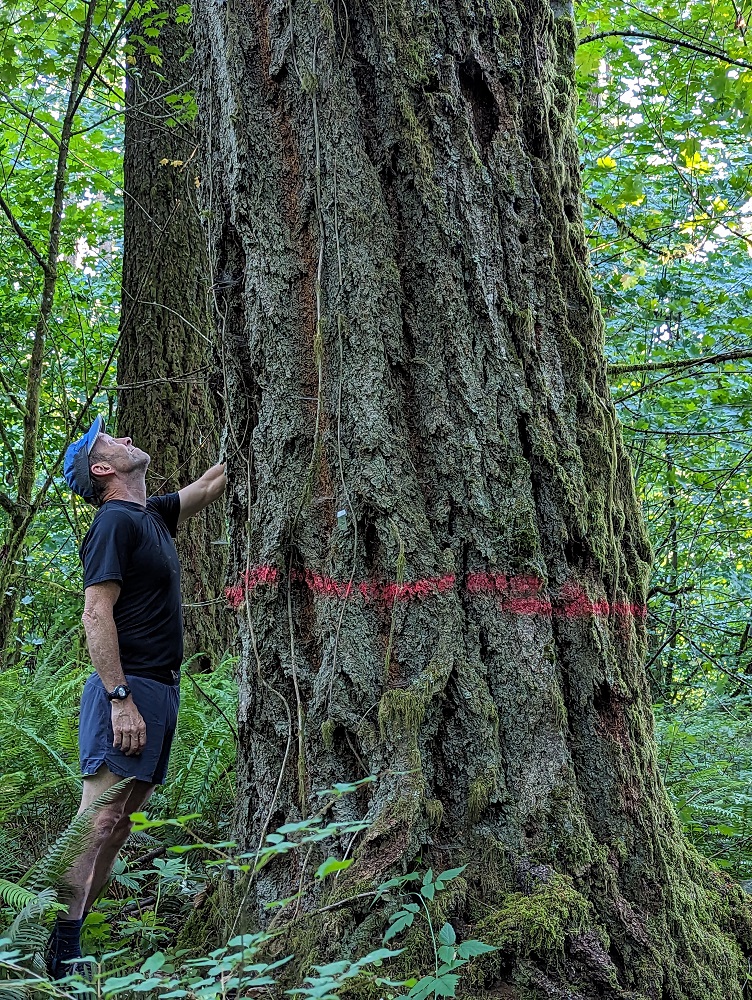
There is NO scientific or research justification for OSU to cut older trees like this one (marked for cutting near Cronemiller Lake).
For those who are familiar with the recreational trails of Peavy Arboretum, the decision of College leaders to log in the heart of this beloved area shows incredible arrogance. They will be thinning right next to the scenic ‘Loop 36 Trail’ which leads from Cronemiller Lake to the old-growth reserves just uphill. I documented a number of trees marked for cutting within areas that are clearly marked “Reserve”. If College leaders were trying to create a public relations nightmare, they have certainly done a good job of it. Over the next 2-1/2 months of logging, thousands of Corvallis citizens will grow increasingly frustrated and outraged as they learn about OSU’s destruction of this cherished, old forest.
Let me be clear: OSU has NO BUSINESS doing ANY logging in this 108+ year-old stand! This is arguably one of the most ecologically diverse and heavily used (and loved) sections of the McDonald Forest. There is NO scientific or research basis that can justify cutting these trees that are well on their way to becoming old growth! Logging will invariably compact the soil, release enormous amounts of carbon, spread invasive weeds, increase predation of threatened species by opening the canopy, and tear up the complex web of the forest community.
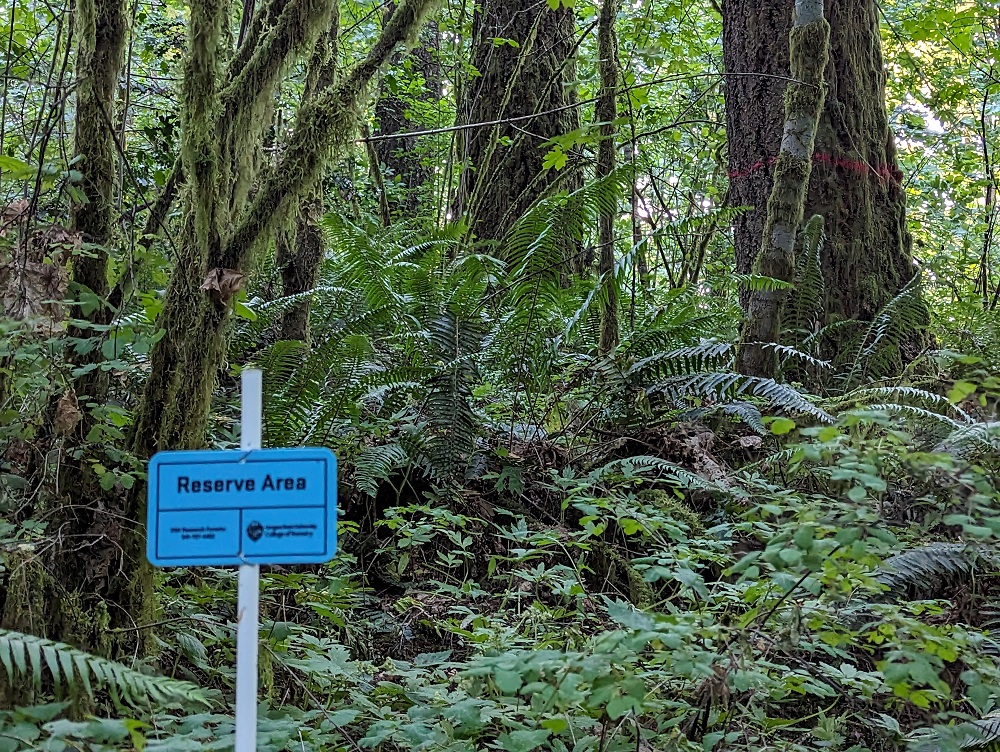
OSU has marked a number of large trees for cutting in apparent violation of their recognized “Reserve Area” near the popular “Loop 36 Trail’.
If you’re offended by OSU’s destruction of this popular, old forest, please send an email to president Murthy and the trustees to share your concerns and outrage. Here are their email addresses:
OSU President Jayathi Murthy: pres.office@oregonstate.edu
OSU Trustees (collectively): trustees@oregonstate.edu
OSU Trustees (individually):
PatriciaBedient@oregonstate.edu
kasaundrabonanno@oregonstate.edu
JuliaBrim-Edwards@oregonstate.edu
StephanieBulger@oregonstate.edu
MariaChavez-Haroldson@oregonstate.edu
SusanClark@oregonstate.edu
RomanHernandez@oregonstate.edu
GrantKitamura@oregonstate.edu
GregoryMacpherson@oregonstate.edu
JulieManning@oregonstate.edu
elisemcclure@oregonstate.edu
InaraScott@oregonstate.edu
Update 6/27/24: In response to overwhelming public outrage, College leaders have decided to “pause, not halt” the cutting of these old trees. You can find links to today’s article in the Gazette Times and Letters to the Editor in our “Latest News” section.
The dean of OSU’s College of Forestry stated in the GT article that he intends to find an ecologist and a silviculturist who will review the proposed cutting to ensure it conforms with the 2005 McDonald-Dunn Plan. He will undoubtedly have little trouble finding “experts” within the College who will rubber-stamp OSU’s logging plans.
Perhaps the dean doesn’t realize it, but much has changed in the science of forestry, societal values, and our climate in the past two decades. We’ve had unprecedented catastrophic wildfires and a “heat dome” event that brought Corvallis to 117 degrees. Climate mitigation goals that once seemed possible have now been cast aside as CO2 levels continue to climb. The federal government has also recognized the value of older forests and has just completed an inventory of mature and old growth forests in response to President Biden’s April 2022 executive order.
Under OSU’s 2005 Forest Plan, any forests outside the tiny sliver of old growth protected in their “mature forest reserves” are largely open to cutting. Less than 4% of the McDonald-Dunn is currently protected in these reserves. The 2005 Plan has exclusions for endangered species habitat (e.g. the northern spotted owl) in the south zone of the McDonald Forest. The dean’s predecessor added protections for individual trees 160 year of age and older. But these very modest protections are now completely out of touch with industrial forestry practices and the expectations of Oregonians. When the average industry rotation (cutting age) is 40 years, why in the heck would College leaders believe cutting trees up to 160 years of age is OK?! The only reasonable answer is that they want the money and think they can get away with it (under the guise of “restoration”).
